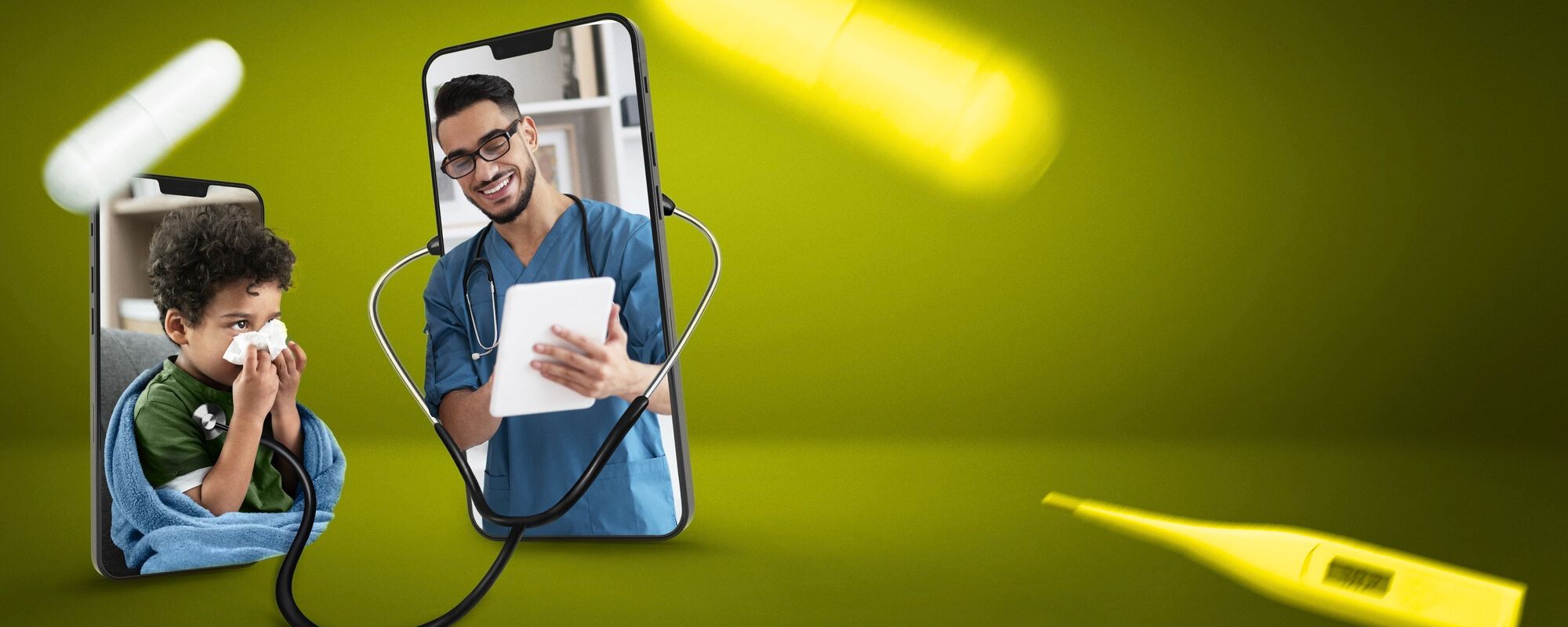The introduction and widespread use of telemedicine have contributed significantly to the dramatic shifts in the healthcare system in recent years. Telemedicine market stands out as a game-changer in the complicated world of modern healthcare, providing a unique combination of accessibility, efficiency, and ease.
Due to rising demand for digital solutions around the world and technical developments, telemedicine has gone from being a somewhat specialised area of healthcare to a widely used service. Healthcare practitioners and patients alike were looking for safe and effective alternatives to in-person consultations during the COVID-19 pandemic, which accelerated its acceptance. The telemedicine sector is poised for further development and innovation thanks to this extraordinary spike in demand.
From its present valuation of $38 billion to $168 billion in 2026, the telemedicine market is projected by Mordor Intelligence to grow at a CAGR of 28%.
Telemedicine Market Trends To Look Forward To In Future
As we look ahead, several key trends are poised to influence the trajectory of telemedicine:
Chronic Healthcare Management
Chronic healthcare management is a critical component of contemporary healthcare, aimed at providing continuous care and support for individuals living with chronic conditions such as diabetes, heart disease, and respiratory disorders. With the advent of telemedicine, the landscape of chronic healthcare management is undergoing a profound transformation, offering new avenues for care delivery that are both efficient and patient-centred.
Reducing the need for physical consultations and hospital visits with telemedicine can significantly lower healthcare costs for both patients and providers. Continuous monitoring allows for early detection of potential health issues, enabling timely intervention and preventing complications.

Telehome
Telehome, often referred to as home telehealth, is a significant subset of telemedicine that focuses on delivering healthcare services directly to patients in their own homes. This innovative approach leverages digital technology to provide medical care, monitoring, and education remotely, aiming to improve patient outcomes, enhance quality of life, and reduce the need for hospital visits or long-term care facilities.
Telehome is particularly beneficial for patients with chronic conditions, the elderly, and those requiring post-operative or palliative care. Patients appreciate the convenience and comfort of receiving care at home, which can also contribute to faster recovery and greater independence.
Internet of Medical Things (IoMT)
With the help of the Internet of Things (IoMT), a vast array of healthcare-related algorithms, apps, and devices can communicate with one another. Better healthcare outcomes are within reach thanks to the data collected by this network of devices.
It collects data in real-time, which improves patient participation and monitoring, medication management, and the precision of diagnoses and treatment regimens.
Electronic Health Records
Electronic Health Records (EHRs) provide a digital version of a patient’s medical history that is maintained by the provider over time. EHRs are more than just a digital replacement for paper records; they are comprehensive, real-time patient health information systems that make information available instantly and securely to authorised users.
In the context of telemedicine, EHRs play a pivotal role in ensuring seamless, efficient, and effective healthcare delivery across digital platforms by including medical history, diagnoses, medications, treatment plans, immunisation dates, allergies, radiology images, and laboratory test results.
EHRs are crucial in the telemedicine market by ensuring that healthcare providers have access to comprehensive patient information regardless of the digital platform used for the consultation. This is crucial for informed decision-making and personalised patient care.
EHRs allow for the real-time updating and sharing of patient information, facilitating coordinated care among different healthcare providers involved in a patient’s care, including specialists and general practitioners engaged in telemedicine consultations.

Health Level 7 (HL7)
Health Level Seven International (HL7) is a set of international standards for the transfer of clinical and administrative data between software applications used by various healthcare providers.
HL7 standards are designed to support a wide range of healthcare information management needs, including:
- Patient Administration: Managing patient records, admissions, discharges, and transfers.
- Clinical Observations: Recording and exchanging observations and measurements about a patient’s condition (e.g., vital signs, laboratory test results).
- Orders and Observations: Handling orders for treatments, services, and diagnostic tests, along with their results.
- Patient Care: Supporting care plans, problem lists, and clinical assessments.
- Pharmacy: Facilitating prescriptions, medication administration records, and pharmacy inventory management.
- Imaging: Managing and exchanging diagnostic imaging orders and results.
Mobile Telemedicine Apps
Telemedicine mobile apps have emerged as a cornerstone of modern healthcare, revolutionising the way healthcare services are delivered and accessed. These apps leverage mobile technology to facilitate remote consultations, health monitoring, and access to medical information, bridging the gap between patients and healthcare providers. Their role in enhancing healthcare delivery is multifaceted, offering benefits that cater to the needs of patients, healthcare providers, and the healthcare system at large.
Enhanced Access to Healthcare Services: Patients living in rural or remote locations, where access to healthcare facilities is limited, can receive medical consultations and advice without the need for travel. Also those with physical disabilities or conditions that make travel difficult can access healthcare services from the comfort of their own homes.
Real-time Health Monitoring and Management: Many apps can sync with wearable devices to monitor vital signs, physical activity, and other health metrics, allowing for continuous health monitoring. Apps can provide medication reminders, track health progress, and record symptoms, helping patients manage their health more effectively.
Personalized Patient Care: Healthcare providers can offer tailored advice and treatment plans based on the patient’s health data collected through the app. Secure messaging features allow for direct communication between patients and healthcare providers, enabling quick responses to health concerns and personalised care guidance.
Cost-Effective Healthcare Delivery: By handling many aspects of care remotely, telemedicine apps can decrease the number of unnecessary in-person visits, saving costs for both patients and healthcare providers. Continuous monitoring and easy access to healthcare advice can help manage chronic conditions effectively, potentially reducing hospital readmissions.
Conclusion
Having explored the telemedicine market, we can perceive that it is rapidly evolving, driven by technological advancements, regulatory changes, and a growing demand for accessible, patient-centred healthcare services. From the expansion of at-home healthcare services to the integration of Electronic Health Records (EHRs) and the implementation of AI and Machine Learning, the trends in telemedicine are setting the stage for a more connected, efficient, and inclusive healthcare system.
The adoption of telemedicine mobile apps, the emphasis on cybersecurity, and the push towards global interoperability standards like HL7 highlight the ongoing efforts to address the challenges and maximise the benefits of telehealth. As the industry continues to navigate these developments, the potential for telemedicine to transform healthcare delivery is immense, offering promising solutions for improving patient outcomes, reducing healthcare costs, and making high-quality healthcare more accessible to all.
How Appscrip Can Make A Difference
At the forefront of this transformative journey, Appscrip’s telemedicine app development solutions stand ready to help healthcare providers, institutions, and entrepreneurs harness the power of telemedicine.
Our comprehensive telemedicine app development services are designed to meet the evolving needs of the healthcare industry, offering features such as real-time video consultations, EHR Integration for smooth access to patient records, secure messaging between patients and medical professionals, appointment scheduling and Remote Patient Monitoring.
By choosing Appscrip for your telemedicine app development needs, you’re not just adopting cutting-edge technology; you’re embracing a partner committed to advancing healthcare accessibility and quality. Our solutions are tailored to empower healthcare providers to deliver exceptional care, anytime and anywhere.
Contact Appscrip today to learn how we can help you bring your telemedicine vision to life, making healthcare more accessible, efficient, and patient-focused.












Nice blog. Telemedicine is a good topic to write on.